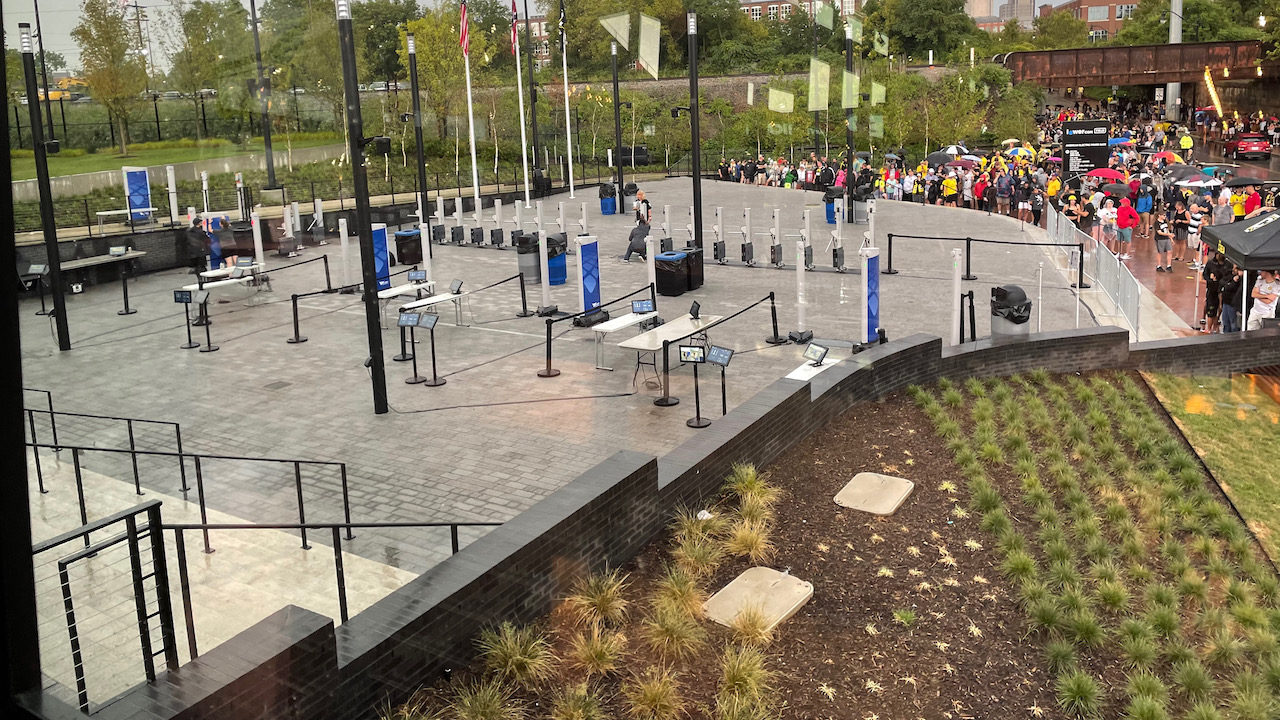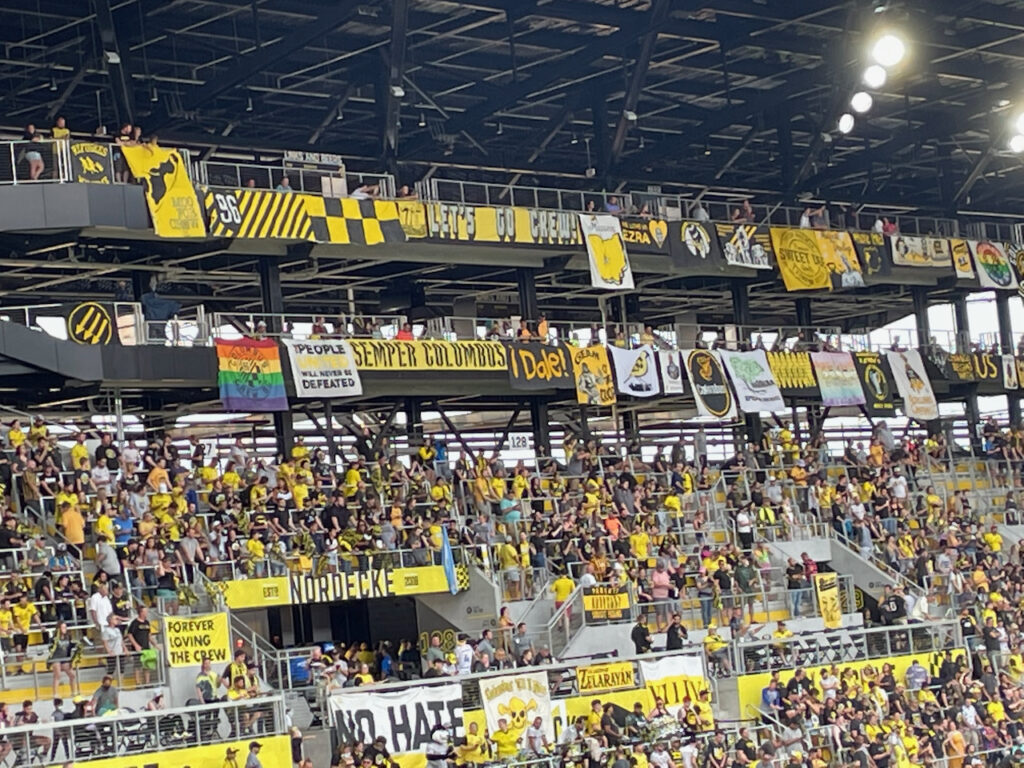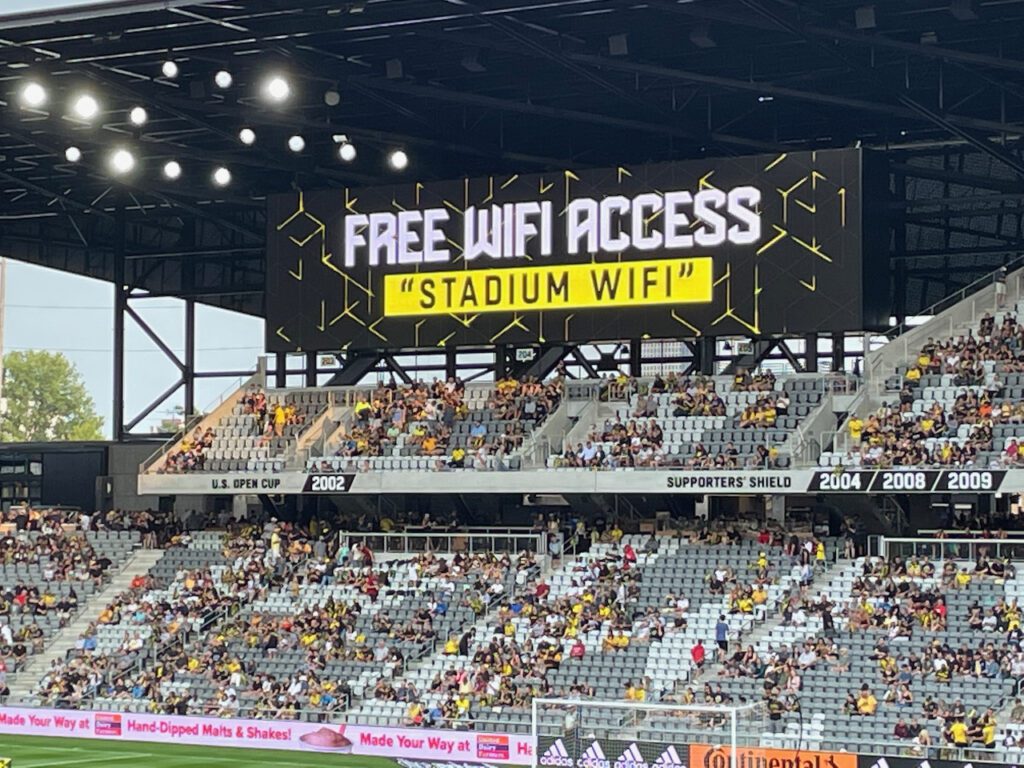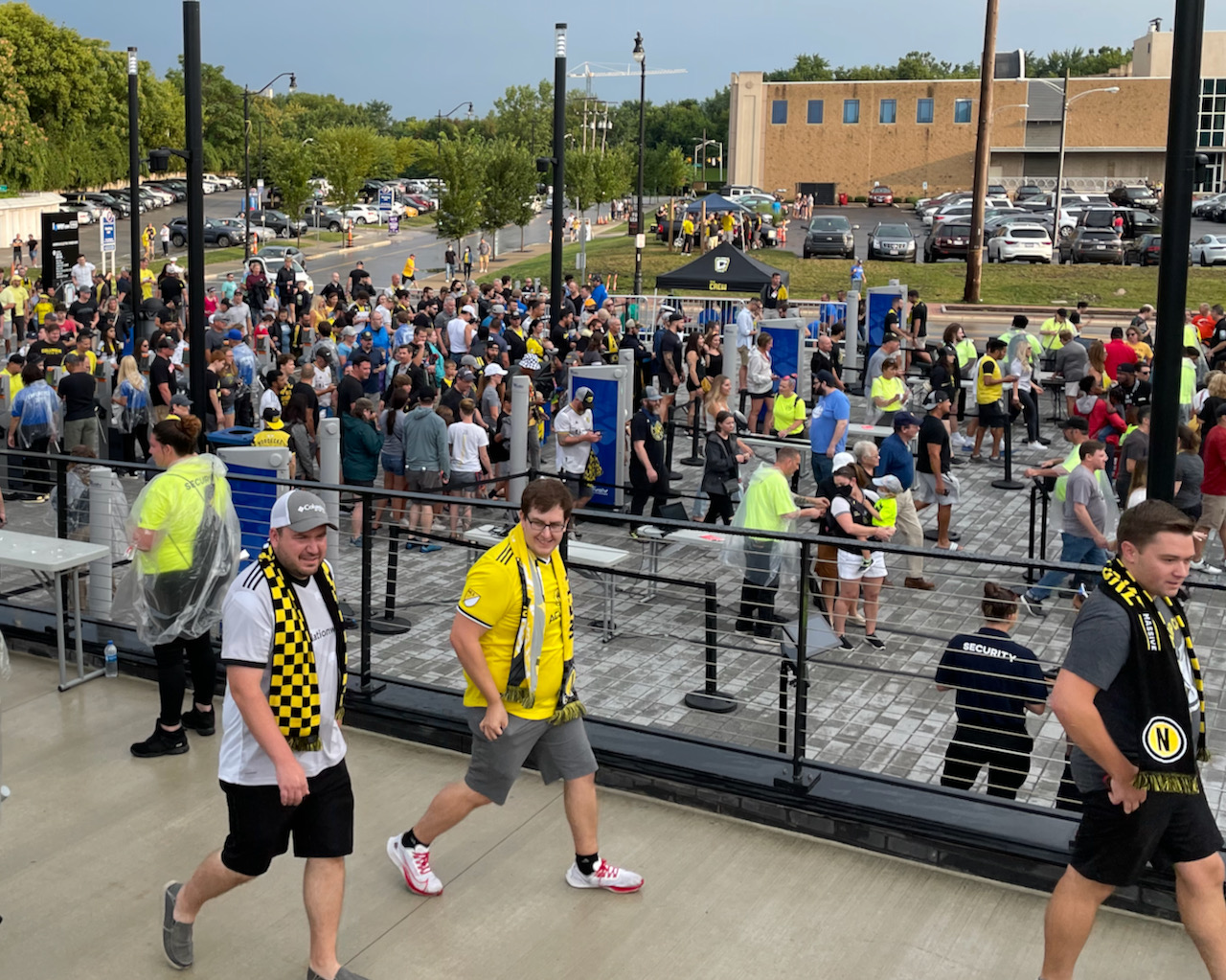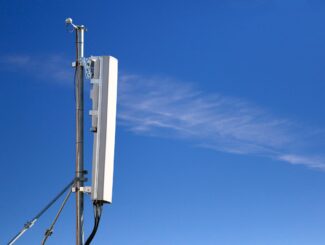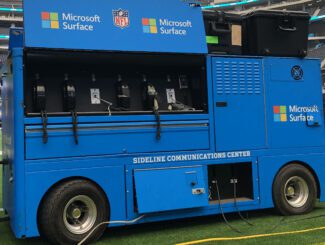Whenever a new stadium opens, the team running the venue knows that an unexpected test of its systems is going to come — you just don’t know when. For the Columbus Crew, there was one big test of its bleeding-edge stadium-entry technology package during the fifth regular-season game ever at the new Lower.com Field. And it arrived in spectacular fashion, in the form of a big midwestern summer thunderstorm that hovered over the stadium a couple hours before game time, flashing lightning and blowing rain sideways.
When the storm refused to cooperate by not going away, the team was forced to keep pushing back the time when it could safely open the gates to welcome fans into the building. Even as the rain still came down, fans were starting to gather in big bunches outside the entryways, waiting for the all-clear. As the delay crept closer to game time, the big question was: Would fans be able to get inside and to their seats before kickoff? Or would there be lines, frustration, and anger?
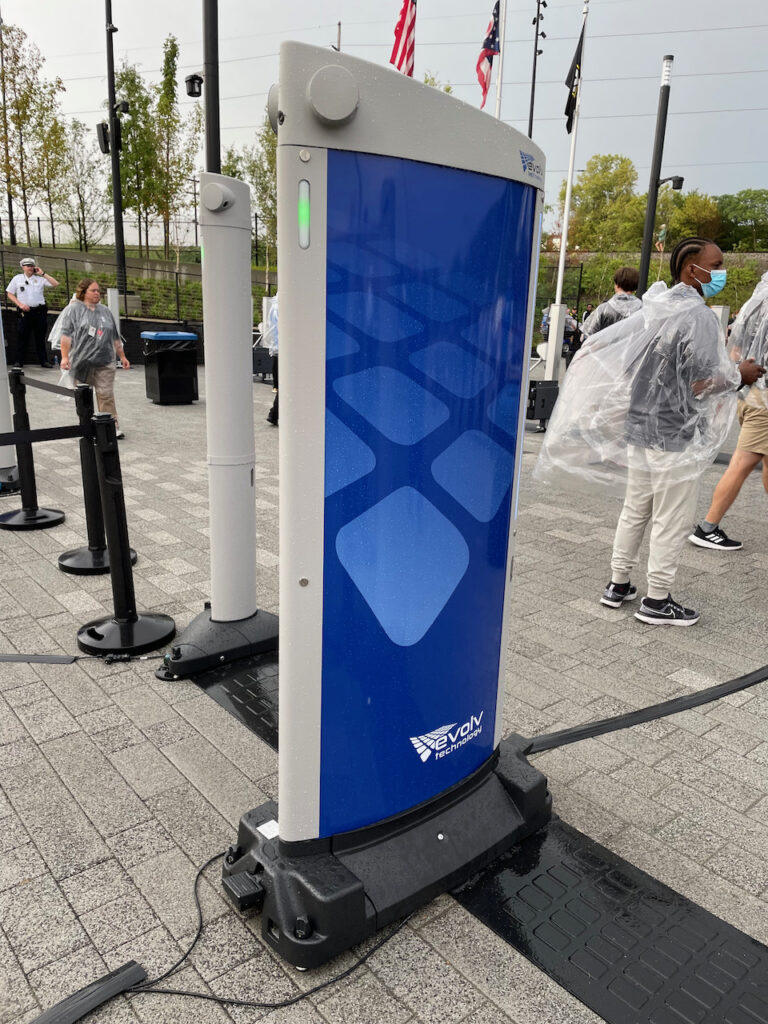
The answer was a happy ending. As soon as the venue opened its gates, fans flowed inside at a pace not seen at many stadiums, at least not those that were not just checking tickets but also performing security screening. Thanks to a deployment of leading-edge technologies that included widespread Wi-Fi, self-scanning ticketing pedestals, walk-through weapons detectors and even a facial-authentication ticketing option, the Crew was able to get its crew of supporters inside in rapid fashion — perhaps heralding what might be the new entry-way standard for other venues to follow.
Stadium Tech Report was on hand for the rain-soaked afternoon of Aug. 7, which turned into a pleasant evening for a match with the clouds departing shortly after kickoff in the game between the Crew and the visiting Atlanta United FC. During our pre-game tour of the brand-new venue and before and during the game we got a good sense that the technology team led by Brandon Covert was delivering on its goals to make Lower.com Field “one of the best venues,” and especially backing up its claim to have “the best, fastest ingress that exists.”
Finding out what fans want most
If you’re not familiar with the recent history of the Columbus Crew, you can do a little research to learn more about the drama from a few years back, when the then-owners threatened to move the franchise to Austin, Texas, if demands for a new downtown stadium weren’t met. In the end, it all turned out well for Columbus Crew fans as the Haslam family — owners of the Cleveland Browns — stepped up and took over the club, with their own plans to build what is now known as Lower.com Field.
For an estimated cost of $314 million, the new downtown stadium opened this year on July 3, with an announced capacity of 20,371 and a sleek, slick look-and-feel that includes high-end premium seating and club areas as well as a dedicated standing section for the Nordecke, the Crew’s most-rabid supporters group.
“Ingress and concessions are the challenging parts of any live event,” Covert said. “Our focus was how do you make it better.”
Underpinning all the amenities was a solid plan for using technology to improve the fan experience, an exercise that Covert said was informed by a “research-based approach” that included significant outreach to fans.
“We asked what do fans want, what do you keep [from the old stadium] and what do you replace,” Covert said. Some recurring themes that emerged included more self-service interactions, more food and commerce choices, and also a desire for easier ways to get in and out of the stadium.
“Ingress and concessions are challenging parts of any live event,” Covert said. “Our focus was how do you make it better.”
In the middle of the stadium’s construction the added challenge of building during a worldwide pandemic arrived, along with the need to address even more fan concerns with touchless interactions and personal safety. Like many other venues that contemplated how to deal with hosting large events in the midst of a still-active virus spread, the Crew’s team focused even more on eliminating lines, especially at the entry to the stadium, historically one of the biggest pain points of any large venue.
Bringing multiple technology advancements to the entry problem
Editor’s note: This column is part of our Stadium Tech Report Fall 2021 issue, which you can read through online or download for free right now! Coverage includes an in-depth profile of new entry technology at the Columbus Crew’s new Lower.com Field, and an in-person visit to Allegiant Stadium, the new home of the Las Vegas Raiders. You can also try it now>> today!!
In recent history, venues of all shapes and sizes have started making moves toward the future, leaving the legacy of hand-punching paper tickets far behind. But the challenges required to safely host large-attendance events, which these days include security screening, bag checks and probably soon vaccination certification as well, can sometimes clash with legacy issues like physical entry gates built decades ago.
And while many if not all teams and venues have moved fully to digital ticketing, especially after the Covid-19 pandemic, the best practices for how to incorporate more technology into entry procedures are still a work in progress. Stadiums continue to suffer from the last-minute ticket download problem, where fans wait until they are outside a venue’s gates to try to load their ticket into their phone, often causing stresses on entryway wireless systems while impatient crowds back up, frustrated that they can’t get inside.
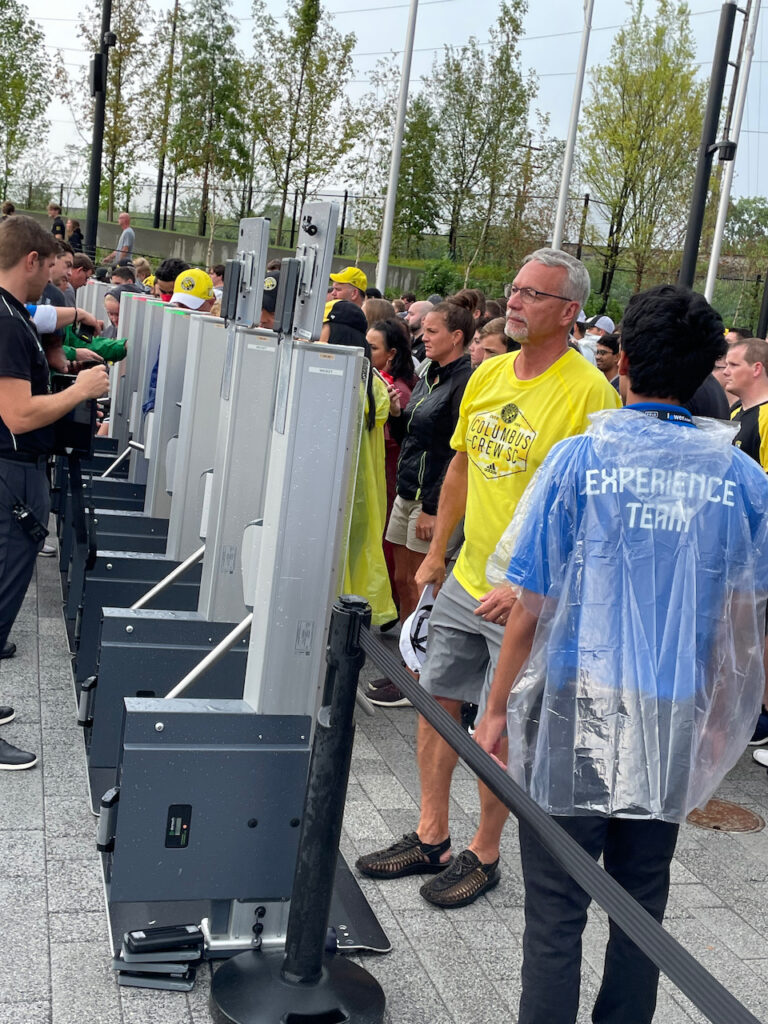
And the fact that there is yet no worldwide default standard among the multiple different digital-ticketing deployment schemes, including near-field communications (NFC) tickets, bar codes and other wallet-type technologies, means that fans can often be confused about which method is the best for any given venue. Some venues are also still using handheld ticket-scanning devices, which require training and a somewhat unwanted human interaction.
The majority of venues today also still are using older single-person magnometer devices, which require fans to empty pockets and purses in a process that be a big bottleneck for entry lines, especially so in adverse weather conditions.
For Columbus Crew fans, however, most of that pain is a thing of the past. If you want to see a vision of what the future looks like, spend some time outside Lower.com Field’s main entryway, where you can see what happens when new technology is combined with a thoughtful plan on how to get fans inside a venue in a far faster fashion than ever seen before.
As a new build, Lower.com Field had the advantage not available to some older venues in that it could design itself physically for easier access. In Lower.com Field’s case that involves a large stair-stepped plaza at the stadium’s southeast corner that is wide enough to accommodate more than 20 separate entry lines. Solid Wi-Fi coverage is provided by access points mounted on light poles throughout the plaza, allowing the Crew to set up the multiple entry lanes in whatever fashion is needed. The ticketing turnstiles, from Austria-based Axess, are battery-powered and Wi-Fi enabled, helping with the flexible positioning.
Though the turnstiles may be different than those fans are used to seeing, according to Renier Steyn, managing director for Axess’s America operation, the devices’ ability to handle any type of input — including NFC, scanned or RFID technologies — becomes familiar after just a few encounters.
“Our secret sauce is that we have no middleware,” Steyn said. “We don’t have a dog in the software race.”
“Like anything else it’s an education process,” said Steyn, whose company is rapidly earning wins at U.S. venues for the flexibility and power of its entry-gate hardware. “By the third game, most people know what to do.”
Steyn said one of the reasons more venues are choosing Axess is because the company directly integrates its hardware with whatever ticketing platform the venue uses. That means a more efficient ticketing solution, with no extra software for users to navigate.
“Our secret sauce is that we have no middleware,” Steyn said. “We don’t have a dog in the software race.”
Using your face to get in
And in a service free for fans who take a minute to register ahead of time, there’s even an easier way to get your ticket checked: You simply walk up to one of the specially designed turnstiles that has an Wicket kiosk mounted on the top, look at the screen and smile.
Using facial-recognition technology from a firm called Wicket, the Crew now allows pre-registered fans to simply walk up to turnstiles equipped with the tablet-like Wicket Kiosk to have their tickets confirmed. Not only is it a much faster process for single fans, but it also appreciably speeds up the ticket-checking time for groups of fans attending an event together, like friends, families or even larger groups who are all sharing a single-transaction purchase.
“If you’re enrolled in the free Crew Express Access program it takes about a half a second for the Wicket Kiosk to recognize you, and you’re in,” Covert said. “And with one scan, an entire group can walk in. With regular mobile ticketing, you can’t do that, you still have to scan every bar code.”
Stadium Tech Report saw visible proof of the facial-recognition speed improvements, as a few families (who had clearly been through the process before) followed the leader quickly past the turnstile. One fan who said he’d heard about the program through social media — and who had a smiling friend follow him in through the already-shorter entry line — said the process was “easy, and fun.”

Jeff Josephson, vice president for venue partnerships at Wicket, said the company was “very proud” of the Lower.com Field deployment, and the speed of entry it is enabling. Unlike some other facial-recognition technologies, Josephson said that Wicket’s system doesn’t actually store any facial information anywhere on the device but instead uses what it calls its “facial authentication” system, which uses artificial intelligence to map a face digitally, and uses that code to authenticate people.
So, if someone were to steal the kiosk at a stadium, “they might get a nice tablet, but there are no photos of people on that device,” Josephson said. According to Covert, Wicket did all the integration to pair the authentication system with the team’s ticketing software, making it a single-step process to look at the screen and be authenticated.
And according to Wicket’s Josephson, for fans the believing is in the seeing.
“The biggest challenge is always training people, and you have to offer value and incentive for new behaviors,” Josephson said. “But when you see the shorter lines (the facial-recognition system users get a separate entry line) and how easy it is, other people ask ‘how do I do that?’ “
No stopping for security screening
After getting their tickets confirmed, fans at Lower.com Field then head through security screening — a process that may confuse, yet delight, fans since there was no gate to walk through, just a pathway bordered by one of the new panel-style screening systems that can scan multiple people at one time, including families, with no need for most to empty pockets or stop for any similar kind of procedure.
“About 95 percent of our fans probably have no idea that they just went through security screening,” said Covert, grinning as he watched the fast, steady stream of fans clear the ticketing area to head into the stadium proper. From our vantage point we watched some people raise their arms (like you need to do in some airport scanners), others look around, before most just kept walking through.
According to Covert the screening system chosen by Lower.com Field, called Evolv Express from a company called Evolv, are “one hundred percent game-changers.” From what we witnessed at Lower.com Field, the Evolv systems lived up to their stated goals of “streamlining the process and eliminating the bottleneck associated with security screening all while improving security and minimizing the need for security staff to interact with fans.”
According to the company, the Evolv Express system uses artificial intelligence to differentiate carried weapons from everyday items such as smartphones, keys, and other personal items, whether those items are carried in by hand or concealed in a bag or pocket. Security staff have multiple mechanisms to help them ensure alerts are not missed; according to Evolv when an alert is raised, a red light on the back of the weapons detector is illuminated first, then a digital photo of the person and an audible alarm are simultaneously presented and signaled on a local tablet.

According to Covert the system typically only requires five percent or fewer of fans to be stopped for an extra search. During our visit most of the alerts we saw seemed to be caused by umbrellas or purses being held under rain jackets.
At Lower.com Field, security staffers watched the alert process from the end of a corral area where fans walked through. According to Evolv and to Covert the Evolv system requires fewer security staffers to operate, but those staffers do have to learn a different process.
“You do need a strong crew to run the entire entry process,” Covert said. But thanks to the self-scanning ticketing system, Lower.com Field and the Crew require fewer attendants at the turnstiles — according to Covert, what used to be a ticket taker for every entry line now sees six attendants covering as many as 24 lanes.
“We’re really proud of the whole system,” Covert said. “We get a lot of joy from the delight that fans have expressed about it.”
Good Wi-Fi and an Elvis singalong
With the big crowd quickly ushered inside — by our estimates it took less than 15 minutes to completely clear the southeast gate entry — fans were able to get to their seats well ahead of the Crew’s traditional pregame singalong, swaying side to side while singing along with a recording of Elvis Presley singing “Fools Rush In.”
A message on both of the stadium’s large videoboards alerted fans to the availability of free stadium Wi-Fi, which was designed and installed by AmpThink using Wi-Fi 6 gear from Aruba, a Hewlett Packard Enterprise company. For most of the bowl seating the APs were installed in under-seat enclosures. For the outdoor areas like the plaza, a small pole-mounted AP was used. In total the venue has approximately 615 APs, according to Covert.

While the stadium’s cellular distributed antenna system (DAS) was not yet active with carrier signals on the day of our visit, the Crew is in the process of signing contracts with all three of the major U.S. wireless carriers. Verizon already had its automatic customer switch to Wi-Fi working when we visited, and without any manipulation our Verizon device connected quickly to Wi-Fi once we were inside.
A few random speed tests of the Wi-Fi signal while walking around saw one measurement of 39 Mbps for download and 55 Mbps for upload (at the southeast plaza area during the ticketing rush) and a 55.4 / 27.1 measurement in the lower bowl just before kickoff. According to Covert the team has already seen games with as many as 9,000 concurrent connections.
A great start with more to come
As one of the original 10 teams that was part of Major League Soccer when it was formed in 1996, the Columbus Crew is now writing a new part of its history, as an organization well ahead of the curve when it comes to using technology to improve the fan experience. Stadium Tech Report plans to cover more of the venue’s attributes, like the cutting-edge IPTV network powered by TriplePlay, and future plans like mobile ordering and express pickup and delivery for concessions.
Local fans should also see more amenities added as the future unfolds, as one of the dirt parking lots in the shadow of the iconic yellow “Crew” smokestack is scheduled to become a mixed-use development with residential and commercial properties. Such nearby associated properties are a growing hallmark for venues everywhere, as teams try to change stadiums from being a drive-up and leave place to a gathering spot where fans can linger before and after events, and perhaps even walk right home. Like the entryway operation, there’s a lot to like about the new ways of doing things at the new home of the Columbus Crew.
